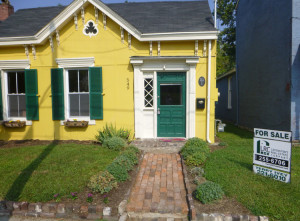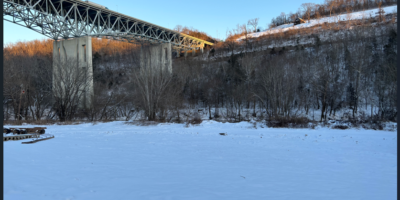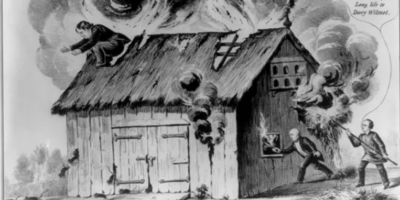In late August, WLEX reporter Dave Wessex delivered a four-minute report on the North Limestone area that stirred a wide-ranging discussion on the North Limestone Neighborhood Association Facebook page. Below is a slightly revised version of NoC editor Danny Mayer’s contribution to that talk.
….
I. As a newer white resident with a college degree and job who bought a nice though somewhat shabby house four blocks north of Main Street on Martin Luther King Jr. Boulevard, I am a gentrifier no matter what I do or say. My actions in the neighborhood must always take that identity into account.
II. Police officer Pape noted two years ago in a meeting attended by several neighborhood leaders and also Council Member at-large Steve Kay that most northside crime has shifted north of Third and to pockets east of the Limestone corridor: places like Ohio, Pemberton, Seventh to the east of MLK. The patterns Pape stated generally describe a further ghettoization of crime from “the northside” into areas that have not yet been discovered by people like me and the new businesses I attend.
III. I heard this information at a January meeting for the New Life Day Center on MLK (located between 2nd and 3rd), which occurred after my neighbor and CM at-large Steve Kay demanded one week of extra police surveillance of the Center to make what he described as “the neighbors” (a nearby business owner, my MLK Neighborhood Association, Sayre) feel secure. At the meeting, I also heard my MLK Neighborhood Association president, speaking on behalf of an organization represented in monthly meetings by 5-10 nearly all white home-owning households, state that extra surveillance of the homeless day center was important to make sure property values did not fall.
IV. The New Life Day Center, unlike any other establishment that has been opened on the northside, is the recipient of a special “neighborhood watch” zone between Second and Third. My neighbors and I have been asked to report to Kay any crime we see committed. We are not able to report “good” things about the center–just panhandling, being made uneasy, etc. There are no metrics, for example, for free cups of coffee served, for positive street interaction like a smile or a “nice to see you and your daughter again this fine morning” spoken by a New Life visitor, despite my and other area neighbors’ requests that these be measured as well.
V. Over the past three years, I have read numerous stories on northside “revitalization” that routinely describe the area in positive/negative terms: positive uplift today, but previously dangerous, downtrodden, and otherwise un-neighborly. These have all been celebrated by the vast majority of new area residents. Along with a vocally supportive city government, these publicly promoted cheers have helped spark private investment, both real and loaned money, during a national depression in which most home values have sunk. Most/all of these articles feature large pictures of new businesses, new business-owners, or recently renovated homes for sale.

This house at 549 N. Limestone is selling for $120,000. The two-bed, one-bath, 800 square foot home was bought by Broken Fork Designs in 2009 for $35,000. It took 39 years years, from 1970-2009, for the homes value to triple; if it sells for $15,000 less tha the asking price, it will have taken 4 years for its value to triple again. Photo by Danny Mayer.
VI. Census data show that the East End, MLK, Jefferson Street, and Main Street tracts have all lost people. The much-celebrated downtown and northside revitalization has resulted in less people here, though it’s often represented as otherwise. (North Limestone has gained population, though its transition–business and people–has lagged those near-Main Street areas referenced above.)
VII. Those who have left, according to the census, are overwhelmingly black.
VIII. Nationally, black home ownership has plummeted since 2007, the start of our current depression. This has led, analysts argue even on mainstream places like MSNBC, to an inability on the part of black residents to purchase the (now cheaper) homes that have been on the market, meaning most of the benefits of low cost housing have gone to white homeowners and investors (me and people like me). Median black household wealth in the United States is now $4,955, which compares to a national median of $110,729 for whites.
IX. This has real implications when one attempts to (1) purchase a house, or (2) come up with cash to renovate or upkeep a house. As examples from other neighborhoods around the U.S. show clearly, these trends will exacerbate as real estate values in the historically dis-invested northside continue to rise. Current black homeowners who have not defaulted from the corrupt sub-prime loans that overwhelmingly targeted African American communities during last decade’s real estate bubble, will make bank. But the future don’t look bright for much of the area’s kids, who can expect to be priced out of the revitalization or ghettoized in off-corridor urban shotgun barracks.
X. The new businesses cited in the recent WLEX newscast that has sparked our present discussions, and in other articles of the area that I have seen, are nearly all white-owned, with most employing an all-white or supra-majority white labor force, people mostly picked from the packs of newly-arrived residents (who are like me).
XI. Many of these celebrated new businesses are bars that serve liquor;many/most employ and patronize people (like me) who do drugs and/or buy drugs from other people, some of whom live in the neighborhood. Yet, I often hear that we need to shut down liquor stores (like black owner Mr. Maxberry’s liquor store where North Lime Donuts now sits) and that we need to get rid of the druggies.
XII. Black is a poor descriptor for “poverty.” There is a small black influx of college-educated and connected residents into the northside. The area also boasts strong middle and working class black homeowners who stayed in the neighborhood after raising children here when it was the Jim Crow social and business hub of black Lexington, people who opted not to move out in the 1970s and 80s to the west end’s black suburbs.
XIII. Given Lexington is 85% white, the area is also not the supra-majority black tract that its reputation exudes. Though it is home to one of the larger populations of black residents, a large number of no-income, low-income, and working class white (and Hispanic) residents have also made homes here, making it one of the most integrated communities in Lexington. It is not, as the Lexington Herald Leader has suggested, only now becoming more integrated with the influx of people like me. Like all gentrifying areas, this is a low-income and working class area, more Cardinal Valley than Mentelle Park or Meadowthorpe—Cardinal Valley with hipsters and Alltech workers and newspaper editors and real estate speculators and artists and students and others who have all decided in the past decade to descend upon it.
XIV. My neighbor across the street, Victor, jokingly calls my side of the block “the suburbs” because I don’t get police harassment for things like drinking a beer in the front yard of my property.
XV. Nationally, critics have noted that the recent proliferation of creative urban hubs like ours has not been productive of many jobs, and that to the degree that they have, they have gone to newer residents. Our creative class narrative is the social narrative of transnational capital writ intimate: financially incentivized actions that rely upon high-cost outside inputs to solve local problems.
XVI. The city’s farcical attempts at attracting a globe-trotting “creative class” as a sound economic investment is but one version of a scaled up gentrification. In both cases, the story lines and economic incentives go toward finding and attracting new (presumably better) talent: those from elsewhere, even dipshits from elsewhere. In both neighborhood and city solutions, what and who is at hand, those who are already our neighbors and resources, get de-classed and implicitly defined as part of the problem.
XVII. Here in Lexington, our Mayor is putting $1.9 million in shrinking national funds designated for spurring low-income employment toward the construction of a downtown art-hotel that will be owned by a billionaire heiress of a liquor retailer. When asked how he justified the money, the Mayor claimed that there were “two tracks” to economic development. The top track, the one 21C will be built for, are imagined as out-of-town visitors (the kind who desire to stay at art hotels) and potential new residents (the kind who like art hotels).
XVIII. The $1.9 million in federal funds will require a certain number of low-income jobs to be created for the second track, which in the case of the art-hotel, will most likely mean porters, maids, etc., all engaged in the task of looking after people who can afford the projected $199+ room rates. The Mayor calls these “good jobs–career jobs” but has given little or no information about the average pay such jobs can expect to demand.
XIX. Nothing has been made of this discrepancy in economic opportunities by my northside neighbors. When I pointed this out defiantly on Facebook, I was shouted down by my fellow neighbors for being rude; when I devoted time writing a developed article on it, there was no response. It was just ignored, though my neighbors and local media did raise a fuss over a lawsuit against a new northside business, a brewery. In three weeks’ time, the beer dispenser received four front page Lexington Herald Leader articles covering its plight, and it managed to self-generate nearly 20,000 energized signatories for a petition to stop the corporate bullying of its—yup, wealthy and mostly white—business owners.
XX. The selective quietness on economic and other discrepancies between the “two tracks” that Gray described has been pretty persistent. Much discussion or uproar of new businesses, art, good urban design, and local food—little or no discussion of the things that Ondine Quinn has recounted in a previous post: poverty, resource allocation, real estate inflation, and elderly and youth displacement.
XXI. Much of the silence on such matters has been enforced. Speaking personally, I have been disallowed by my neighborhood association from circulating emails that have questioned the policy of selective surveillance of the New Life Day Center; I have heard no feedback—actually a direct statement of disinterest in involvement from one council member—on ideas for expanding our food access into lower income neighborhoods across the city. Emails to my Mayor and city council at-large member/neighbor do not ever seem to register. Downtown and the northside is always, to them, booming and worthy of the city funds and media stories they have been receiving in greater proportions.
XXII. Downtown is slated for over a billion dollars in upgrades–a thin sliver of county land appearing on the map as a middle finger. Much of this will come from Tax Increment Finance (TIF) zones, which will divert county-wide tax growth into specific areas. This means, practically, that the northside, which is not part of the TIF zones, will soon be receiving less and less of its share of city tax monies that will be generated, so we are told, by our considerable investment in creating a thriving downtown (as, most likely, will your neighborhood miss out).
XXIII. This will have unequal consequences on the two tracks of northside residents (as it will on different residents in your neighborhood).
XXIV. I’m glad to see that people are starting to feel comfortable talking gentrification. More of this needs to happen, but we also need to be holding our public officials and area leaders—the same business people, neighborhood representatives, and cultural figures who always get quoted in the papers—more accountable for their words and their actions. We must also do the same.
XXV. We need to care less about surface aesthetics and more about core needs for an entire community.




Alleyway Collective Lexington
Danny, if you will, please contact me. I’m interested in speaking more on this issue and parsing as much information/sources from you possible. I found your article illuminating and insightful!
Please contact me at: alleywaycollectivelex@gmail.com
Dave Shattuck
So, Danny, are you saying you’re part of the problem AND part of the solution?? :o)
Nice to hear some good thoughts on the subject. Keep up the good work!
Danny
Dave, as most of my good Lexington northside neighbors will attest, I’m just part of the problem.
On a somewhat related issue, have you seen the LFUCG Bicycle and Pedestrian Advisory Committee’s statement on two-way conversion? Though discussion of two-way conversion’s impact on biking hasn’t really made it into our good paper of record–not even uber-biker Tom Eblen’s columns–the Bike/Ped Committee finally (after 2-3 years?) thought it wise to start thinking about its effects. (Incredibly, I think they are the only bike-related group here in Lex to actually spend time thinking about the effects of two-way conversion.) Surprise-surprise–two-way conversion doesn’t seem to be good for downtown bikers, either. I’m pasting a draft version of their letter that they plan to quietly send up the channels. They haven’t actually finalized the June draft yet, I’m guessing in part to allow good CM-at-large Steve Kay, the public rep serving on the committee, to help delay and water-down their findings in order to help his good buddy Jim Gray cram two-way through.
d
Consultant/Decision Makers,
The following summary is an “Opinion of Probable Impacts” to bicycle & pedestrian circulation and safety as it relates to the Downtown Lexington Traffic Movement & Revitalization Study. The BPAC opinion of probable impacts has been developed based on personal & professional experience and the current levels of service provided to bicycle & pedestrian modes of travel under the current one way traffic circulation pattern.
OPINION OF PROBABLE IMPACTS
The Level of Service model used in the study reports no negative impact to bike/ped LOS but this can be misleading as it does not account for all elements of safety and comfort including crossings, conflicts, ease of passing a cyclist, etc. BPAC recognizes that tools/studies are generally not available for measuring such impacts and wish to help provide this insight and feedback for consideration.
Future reports and presentations for the study should provide more qualitative comparisons and discussions on the impacts (positive or negative) for bicycle & pedestrian circulation in the various alternatives.
The current study evaluates the multimodal level of service but does not account for possible loss of bike lanes and safety at crossings
Cross-sections are needed to best review impacts.
Proposed cross sections of roadways converted to two-way traffic would allow for a more concise determination of impacts on bicycle & pedestrian circulation of safety.
Slower traffic speeds are positive for bicycle & pedestrian safety & comfort.
Slower traffic speed would benefit all modes of travel and can provide the active modes with higher level of comfort & safety.
Reducing speeds may allow bikes to better mix with traffic, but if speeds are not reduced to casual cycling speeds passing will still be necessary and/or cyclists will delay vehicles.
Potential for increased pedestrian/vehicle conflict points at intersections, midblock crossings and garage entrances.
Mid-Block Crossing and unloading of children for various services, i.e. Lexington Children’s Museum, Opera House and the Explorium.
Left hand turns yielding to on coming traffic and the effect on pedestrian crossings at these intersections.
Parking garage entrances & exits accessed from both directions increase vehicle & pedestrian conflicts.
Loss of bike lanes and/or additional through travel lanes which ease passing of cyclists by vehicles. This is of more concern on Upper/Limestone and Main/Vine than on Short/Second.
One way traffic patterns provide an entire travel lane for passing cyclists without pinching the rider into the curb or parked vehicles.
karen
Danny, you rock! You are definitely the most honest person I’ve heard to speak on these issues. Wow! I mean, at least you admit you are part of gentrification, but you do have a moral compass. You admit that you enjoy a beer, that you, or at least white people you know, do and buy drugs in the neighborhood.
It’s like white privilege. We are part of the problem and want to be part of the solution.
In the case of gentrification of the north end, I am one who has been displaced….way north to Paris.
You’re very intelligent and obviously have done your research. You’re sending your emails and attending meetings… but you’re up against Lexington’s snobbery and a government that turns a deaf and dumb ear…pun intended.
2-way conversion. Really? We did that already. The creation of so many one way streets downtown was ingenious. It works better in every way. The only people I hear complain about “too many” are young, new to Lexington or can’t remember how bad traffic was before one way streets and left turn on red…plus, what a waste of money. It’s so illogical I can’t wrap my head around it.